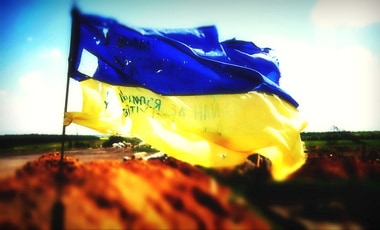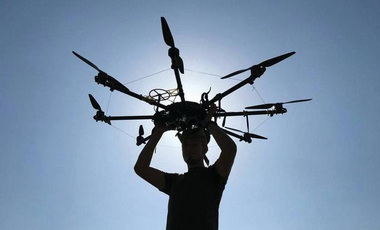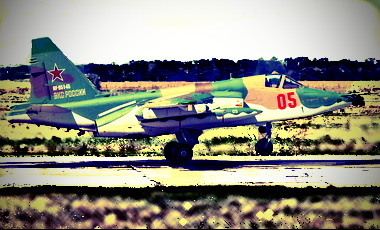Russia/Ukraine


3-Year Anniversary of Ukrainian War | Armstrong and Getty

Ukrainian Drone Deploys Modified TM-62 Anti-Tank Mines
This is pretty amazing. Drones have already changed early 21st century warfare (as this war between Russia and Ukraine has shown). But these are free munitions left behind by Russia that are now being modified from a defensive weapon to a powerful offensive weapons. Russia has littered many a field with these over the years… will countries leave mines on the battlefield en masse now? Knowing drones can deliver them ON-TO their targets — from the air?
FUNKER530’s WILL KILLMORE has this (click mine to the right to enlarge):
Ukrainian drone operators demonstrate resourcefulness in a video showing a drone dropping T-62 anti tank mines that are tandem linked to grenades, giving them the ability to deliver much higher payloads onto enemy targets than standard drone-dropped grenades.
As Russian lines have fallen back, they have left behind massive caches of munitions, including piles of powerful anti tank mines. Considering a buried mine is of little use to Ukraine’s counteroffensive, they have ingeniously developed a way to make those munitions an offensive weapon.
The construction of the weapon is especially interesting. It appears a one-gallon jug is being used as a fin stabilizer at the base of the grenade to ensure the munition drops in the correct fashion for dependable detonation upon impact.
RYAN ROBERTSON discusses the Russian doctrine and tactics that I assume must change now:
….This war is full of great examples of battlefield engineering, but this new strategy certainly tips the scales in terms of ironic ingenuity.
Russian defensive doctrine calls for minefields with a depth of 120 meters. In Ukraine, the Russians adjusted their doctrine and quadrupled minefield depths up to 500 meters.
In August, Oleksiy Danilov, the former secretary of Ukraine’s National Security and Defense Council, told reporters at CNN the density of Russia’s minefields was “insane.”
“On average, there are 3-4-5 mines per square meter,” Danilov said. “Imagine how difficult the work is to remove them to allow our military to move afterwards. And if earlier there were hopes that this could be done with the help of equipment provided by our partners, today our units are doing a very difficult job on foot in many parts of the frontline at night.”
Russian artillery and defensive trenches are certainly formidable, but the complexity of Russia’s minefields was far and away the biggest challenge to Ukraine’s three-month-old counteroffensive. Now, they might be a primary source of new munitions for Ukraine.
Drone delivery system for a TM-62 mine with a grenade fuse. That is 7kg of explosives…https://t.co/94NR8t0fMl pic.twitter.com/UstUic0tDw
— Def Mon (@DefMon3) September 3, 2023
A video circulating on social media shows how the Ukrainians modified commercial drones to carry their new payload. The explosive is equipped with a grenade fuse and then put on a platform on the drone’s underside. When the drone is over its target, the pilot releases the platform and drops the mine. Designed to stop tanks, the air-dropped mines make quick work of softer targets.
Ukraine’s ability to use commercial drones on the battlefield is a large part of why it’s still in the fight……
That pic above/right near the top is from this Tweet… if you go to that Tweet, you can see more video of the drops:
TM mines dropped from the drones get a lot of engagement today.
My good friends pioneered this method. I’ve posted about it several times, but I need more engagement.
So, let me try once again.
Here is what the mine looks like: pic.twitter.com/uuGnAV2Icc
— ✙? Constantine ?✙ (@Teoyaomiquu) September 6, 2023

Arguing for Supporting Ukraine (Levin and Prager)
Mark doesn’t understand how some of today’s so-called conservatives are siding with Putin and his sinister attack on Ukraine. The U.S. must help the democratic Ukraine because if Putin takes the country, Russia’s border countries are next, including two NATO allies, Poland and Romania.
Dennis Prager speaks to this monologue by Levin: “Ukraine Needs Our Help”

Why Are Conservatives Ambivalent In Supporting Ukraine? (Prager)
Sebastian talks to fellow Salem Radio host Dennis Prager, founder of PragerU and author of “The Rational Bible” series, about the ongoing debate on the Right over whether or not to support Ukraine.
(Isolated the comment I wanted)

2-Parter via Dan Bongino | Biden Family Corruption
PART 1: Joe Biden is a Foreign Agent, The Case Is Closed (Ep. 1941) – The Dan Bongino Show
This recording of Joe Biden blows the doors off the Biden Inc. scandal, and it provides additional evidence that Biden is a foreign agent. Don’t miss this show.
PART 2: The Soros Biden Connection Exposed (Ep. 1942) – The Dan Bongino Show
In this episode, I address the disturbing connections between liberal donor George Soros and the Obama/Biden machine.

The Biden, Soros, Ukraine Connection (Dan Bongino)
The Biden, Soros, Ukraine Connection (Ep. 1931) – The Dan Bongino Show: In this episode, I address the shocking connections between the Biden documents scandal, the Russia hoax, the impeachment hoax, Ukraine and George Soros.

POV: Russian Pilot Ejecting From His Shot Down SU-25SM3
Incredible footage released to the internet today shows a the POV of a Russian pilot as he ejects from an Su-25SM3. As far as I know, this is the first and only footage like this that exists.
HERE IS THE FULL VIDEO

US Vet Describes Horror From Ukraine’s Front Lines
Just how cruel has the Russian military been during its onslaught against Ukraine? Chad Robichaux, a U.S. combat veteran and Founder of Mighty Oaks Foundation, tells Glenn the Russians have committed certain horrors during today’s conflict with Ukraine that he hasn’t witnessed in any other war. Recently returned from the front lines, Robichaux describes those horrors that he witnessed firsthand. Plus, he tells Glenn he hasn’t seen proof of any significant American relief there, despite the billions of dollars sent to Ukraine from the U.S. government. So where DID the money go?!

Ukrainian Drone Records Itself Being Shot Down
While conducting aerial reconnaissance and correcting artillery fires, a Ukrainian observation drone records itself being shot down by a Russian air defense system’s surface-to-air missile.
MORE BACK STORY:
Stunning footage released by the 45th Ukrainian Artillery Brigade camptured the moment when a Ukrainian drone filmed itself being shot down by a Russian anti-air missile while after spotting a Russian military vehicle and coordinating artillery fire.
The drone was flying over a oil plant in Pologi in the Zaporozhye region of Ukraine when it spotted a large number of Russian military vehicles.

Did the Russian Missile Cruiser Have Nuclear Weapons On Board
The ship that Ukraine sank was the ship that reportedly took those guys on the island captive that told the ship to “go ‘effe’ yourself” when told to initially surrender… how the tables turn:
(Final Cut) Russian warship, idi na huy! Sound on! ?#Moskva #StandWithUkraine ???? MUSIC by: @MaxBarskih ORIGINAL ART by @BorisGrohArt pic.twitter.com/mUyzeu5c4v
— Russ Castella (@RussCastella) April 16, 2022
 News on the possibility that the Russian Missile Cruiser May Have Had Nuclear Weapons On Board, what the U.S. Military calls “Broken Arrow,” a situation with potentially lethal accidents involving nuclear weapons. DAILY MAIL:
News on the possibility that the Russian Missile Cruiser May Have Had Nuclear Weapons On Board, what the U.S. Military calls “Broken Arrow,” a situation with potentially lethal accidents involving nuclear weapons. DAILY MAIL:
Russia’s ‘broken arrow’: Fears that NUCLEAR MISSILES sank with Putin’s flagship Moskva amid claims that 452 of the 510 crew have drowned and top admiral has been arrested after cruiser was ‘hit by Ukrainian missile’
- Moskva, the flagship of Russia’s Black Sea fleet, has been confirmed to have sunk near port of Sevastopol
- Experts and analysts are now warning that the warship may have been carrying two nuclear warheads
- They are calling for an urgent probe into ‘broken arrow’ incident – military slang for an accident with nukes
- Meanwhile questions remain over the fate of Moskva’s 510-strong crew, most of whom are unaccounted for
- Ilya Ponomarev, a politician exiled from Russia, said as many as 452 members of the crew could have died
Russia’s Black Sea flagship which sank yesterday after an explosion on board may have been carrying nuclear warheads, analysts and experts have warned today, as a Russian politician said more than 400 sailors could have gone down with the ship.
The Moskva, a Soviet-era guided missile cruiser, sank near the port of Sevastopol on Thursday after Ukraine said it hit the ship with two cruise missiles. Today, Mykhailo Samus, director of a Lviv-based military think-tank; Andriy Klymenko, editor of Black Sea News; and Ukrainian newspaper Defence Express all warned that the Moskva could have been carrying two nuclear warheads designed to be fitted to its P-1000 ‘carrier killer’ missiles.
If true, the loss of the warheads into the Black Sea could spark a ‘Broken Arrow’ incident – American military slang for potentially lethal accidents involving nuclear weapons.
‘On board the Moskva could be nuclear warheads – two units,’ Samus said, while Klymenko called on other Black Sea nations – Turkey, Romania, Georgia, and Bulgaria – to insist on an explanation. ‘Where are these warheads? Where were they when the ammunition exploded,’ he asked.
Meanwhile Ilya Ponomarev, a politician exiled from Russia for opposing Putin’s 2014 annexation of Crimea, said just 58 of the 510-strong crew have since been accounted for – raising the prospect that 452 men went down with the ship in what would be a bitter loss for Vladimir Putin’s already beleaguered army.
The figure, while unconfirmed, is consistent with losses suffered on exploding warships. During the Russian Navy’s infamous defeat at the Battle of Tsushima against Japan, an explosion on board the Borodino – slightly smaller than the Moskva – saw all-but one of her 855 crew killed.
[….]
Leonid Nevzlin, a Russian-Israeli businessman who fled the country in 2003 after being targeted by Putin, said yesterday that 20 Russian generals have been arrested over the military’s failings along with 150 FSB officers for providing false information about Ukraine’s defences…..
The WASHINGTON POST has a good article as well noting that this anti-ship missile is 100% Ukraine made:
Soon after Russia seized Ukraine’s Crimean Peninsula in 2014, a Ukrainian defense firm used an arms show in Kyiv to unveil its latest project: an anti-ship cruise missile it called “Neptune.”
The new missile drew little attention at the time. But now it is in the spotlight after a U.S. defense official said Ukrainian forces used Neptune missiles to strike and sink Russia’s flagship Moskva war vessel in the Black Sea.
The strike on Wednesday marked a major boost for Ukraine — not only for its war effort but also for the homegrown arms industry, even as it relies on weapons donated by Western allies.
“For the Ukrainians, if they were able to sink this ship or damage it with their own Neptune missiles, that’s a point of pride, first, and a useful military capability in that they will be able to keep the Russian fleet at bay,” said Mark Cancian, senior adviser for the international security program at the Center for Strategic and International Studies.
[….]
“For the first time, a warship was destroyed by an anti-ship missile made entirely in Ukraine,” Daria Kaleniuk, executive director of the Anti-Corruption Action Center in Ukraine, wrote on Twitter.
The Neptune was in development before Russia’s annexation of Crimea, but the territory’s capture helped spur the missile’s production. The peninsula houses Ukraine’s main navy base and the Soviet-era coastal defense systems that had once protected the country from attack along the Black Sea.
The R-360 Neptune is itself based on an old Soviet cruise missile called the Kh-35, which had been produced in the Ukrainian town of Kharkiv. The company that developed Neptune, Luch Design Bureau, was founded in 1965 and had a long history of designing Soviet missiles.
If Neptune missiles were fired at the Moskva, it would mark the first time that the weapon was used in practice, military experts say. The incident also suggests that the cruise missile, which has a stated range of about 200 miles, can evade missile defense systems such as those onboard the Russian ship.
The ship was fitted with long-range radar and an S-300 air-defense system, designed to provide protection not only for itself but the rest of the Russian fleet. Accounts from Ukrainian officials suggest that an aerial drone was used to distract the defense systems during the attack……..

Operator Starsky (Ukraine Updates and Q-n-A)
Bucha, Hostomel, Irpin: Day 42 Update
As promised, a small Q&A for you, guys. Since there were hundreds of your questions, I decided to make a bunch of vids answering 10 of them in every episode, because I don’t want you, guys, to fall asleep watching three hour long vids.